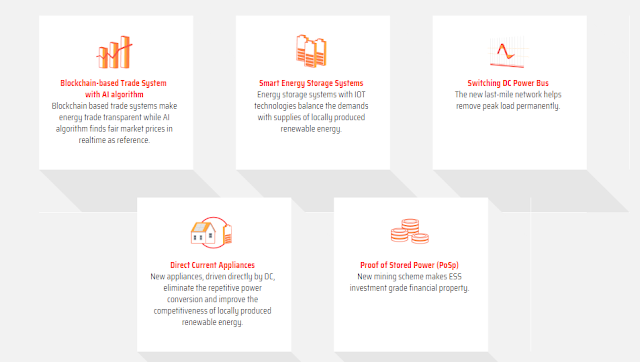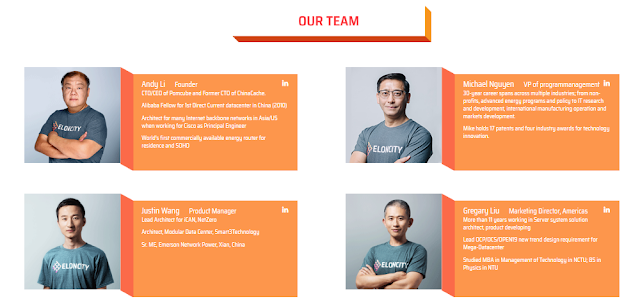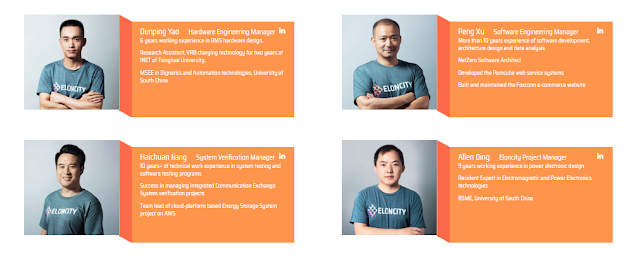ICO or Initial Coin Offering lately more incessant progress. a lot of developers are using this method to raise funds for the sake of developing their projects. The funds collected can reach millions of US dollars.

They collect funds from their Project by selling their ICO Coins, exchanged with Ethereum coin or Bitcoin in a very different ratio.
And if you want to buy Coin from their Project you must have Ethereum / Bitcoin balance and must have ID or Passport.
Today there are so many Investors from around the world who invest their money into a Project that they think Project is very good and useful for now and in the future.
Well on this occasion the Markas Coin IND will give you information on the Eloncity ICO Project.
Projects and Team of Projects ICO Eloncity are very great. And after I'm the analysis of this Project is very useful in the Future. I have also invested in this project.
If you want to find out about the Eloncity project. You can search for them by reading their whitepapers, roadmaps, and websites. And if you want to ask you can join their Telegram Group.
Okay before you visit the official site or read their whitepaper, it would be nice if you read a little article Markas Coin IND about the Eloncity Project. Let's talk about Eloncity Project together.
OVERVIEW
Our modern life depends on the vast electric grids to power everything from light bulbs to mass transit subways. Despite tremendous strides in technological innovation, the existing grid is largely built on an aging design. This design is essentially a centralized grid architecture based on large power generation plants in remote locations that are connected to the customer sites through a complex labyrinth of transmission and distribution (T&D) network. The coordination of electricity production in alternating current (AC) combined with delivery through the complex T&D network is managed by regional system operators or independent system operators (ISOs). The ISOs must balance not only the electricity production and consumption in real time, but also ensure the electricity produced remotely is transported to customer sites without running into congestions on the vast T&D network. While the current electric power grids are a marvel of engineering feats, this enormously complex centralized power grid design is showing its age. Today’s centralized power grids face significant challenges in providing safe, reliable, secure, and affordable energy services.
PROBLEMS OF MODERN CENTRALIZED POWER GRID
Environmental and Public Health Problems, California October 23, 2015 – The underground natural gas storage located in Aliso Canyon (Los Angeles) had a massive leak1. This storage facility is the second-largest natural gas storage facility of its kind in the United States, and it supplies gas to electric power generation plants throughout Southern California. The leak problem was so dire that it prompted California Governor Jerry Brown to declare a state of emergency on January 6, 2016. This Aliso Canyon incident created the environmental disaster that was estimated to be larger than the Deepwater Horizon accident in the Gulf of Mexico. It was assessed that the Aliso Canyon gas leak released approximately 5.3 gigatons of harmful methane gas into the Earth’s atmosphere, or equivalent to about 12,800 years of the total annual emission of the entire South Coast Air Basin in Southern California. The power utilities in Southern California implemented contingency plans in anticipation of the natural gas shortages for powering the local gas-based electric plants. In the meanwhile, the local residents reported headaches, nausea and severe nosebleeds. About 50 children per day saw school nurses for severe nosebleeds. By January 2016, nearly three thousand households or about eleven thousand people had been temporarily relocated while more than 6,500 families have filed for help. There are other numerous but disastrous centralized grid accidents such as the Chernobyl and the Fukushima incidents. In the Chernobyl nuclear power plant catastrophe2, over 300,000 people were forced to relocate permanently. This nuclear accident released traceable airborne radioactive particles in all countries in the northern hemisphere. As these few examples attest, the centralized grids pose increasingly unbearable impacts to the environment, health, and safety of the people that it serves.
Safety and Reliability Problems, California September 8, 2011 – A deficient equipment maintenance procedure at a transmission switch station in Yuma, Arizona, initiated cascade grid power failures that left more than seven million residents without electricity, from San Diego County to western Arizona and Tijuana3. This major incident exposed the inherent susceptibility of the centralized power grid to point-vulnerabilities. Like the Aliso Canyon gas leak incident, a failure at one single point on the centralized power grid could cause adverse impacts to millions of customers over vast areas. Whether natural or human-induced accidents at any vulnerable points that could be located anywhere on the complex centralized power grid sprawling over the vast geographical areas, the existing power grid’s ability to guarantee safe and reliable energy services looks to be increasingly challenged.
Adaptability and Resilience, Melbourne, January 28, 2018 – More than 10,000 homes in Australia’s second most populous state were stuck without power as a surge in power demands from the scorching heat wave overloaded the grid4. This blackout was caused by a power network failure, rather than supply shortages. It impacted more than 50,00 homes. This came less than a year after Australia’s largest City, Sydney, was hit by blackouts during another heat wave. During an intense heat wave, power demands can precipitously peak as customers increase their air conditioning. Meanwhile, the grid T&D wires and electric power plants experience reduced electricity transmission and generation due to increased ambient temperature. In the foreseeable future of climate change, cities around the world are expected to experience growing incidents of grid failures due to adverse weathers. From heat waves in Australia and California to frigid winter spells in the northeastern US, to hurricanes Katrina, Sandy, Rita or Maria, we have witnessed repeated episodes of massive grid failures due to the system’s inability to adapt and absorb the disruptions brought about by climate-change-induced events.
Unaffordable Electricity Cost, USA April 14, 2016 – According to a study by Groundswell, a nonprofit renewable energy advocacy group, the cost of electricity is increasingly burdensome for America’s working class. The study reports the bottom 20 percent of earners spend about 10 percent of their income on electricity5. There are a few reasons for centralized grid’s high costs of electricity: (a) Five to nine percent6,7 of the total energy produced is lost during the electricity transmission and distribution. As discussed above, the T&D losses amplified during hot weather spells due to increasing resistance in the T&D wires and equipment as temperature rises; (b) the electricity in AC is relatively complex which requires numerous supporting resources, called ancillary services, to ensure the delivered powers at customer sites remain within the required power quality limits. Examples of ancillary service would be frequency regulation, and voltage-level regulation. Unfortunately, the required ancillary services for the centralized AC grid are costly and account from three to seven percent of the total electricity bill8; (c) Capacity services to ensure adequate power generation capacity to maintain grid reliability during periods of peak demand. The capacity services or standby capacity reserve are compulsory because the today’s power grid lacks real-time coordination of customer power demands with the system’s available power supply. In another word, since the real-time management of power demands at customer sites lacking, the centralized grids procure excess generation capacity to standby just in case they are needed. These capacity services are also costly and can add up to 15 percent of the total bill9. These examples are just a few of the innate and costly inefficiency of the centralized AC power grid design that drives up the cost of electricity for all ratepayers.
Eloncity Features
THE SOLUTION - THE ELONCITY MODEL
With the challenges of natural disasters, population growth, and climate change, new approaches to energy production and distribution are needed. The solutions must warrant vibrant and sustained growth for all. AI Grid Foundation (Foundation) is a non-profit organization based in Singapore who advocates for employing decentralized renewable energy as a possible pathway to address the problematic centralized AC grids as mentioned above. The Foundation has collaborated with global organizations and local communities to develop the Eloncity Model; a multifaceted solution that employs decentralized renewable energy resources to eradicate barriers to attain safe, healthy, vibrant and equitable energy future.
Decentralized renewable energy is employing locally available renewable resources, such as solar or wind power, to produce electricity locally where it is consumed. When energy customers in a community coordinate with each other to exchange energy and share energy equipment costs-benefits (e.g., solar PV, BESS, energy management system, and others) to access more reliable and cost-effective local energy supply, to maximize the utilization rates of the installed equipment for accelerated return-of-investment (ROI) and other benefits, they essentially create a community-based renewable microgrid. This type of decentralized community-based renewable microgrid holds tremendous potential for fortifying the centralized grids and solving the problems threatening our energy safety and security.
The proposed Eloncity Model integrates advanced technologies, best practices and lessons learned to create a scalable and replicable recipe for unleashing the potential of the community-based renewable microgrid to attain a more vibrant regenerative energy future. The Eloncity Model builds upon four key pillars:
1. A decentralized renewable energy architecture, which comprises of:
• A high-performance blockchain technology platform that provides an open, secured and distributed ledger for efficient recording of high-volume and high-speed energy transactions in the community. The blockchain platform also enables the Eloncity community to establish an auditable record for tracking the sources of electricity generation in the community, renewable or fossil fuel. The auditable tracking of electricity generation sources is critical for valuation of electricity based on generation sources and monitoring the community’s progress toward de-carbonization. Fundamentally, the blockchain platform will allow for increased collaboration and sharing of resources in mitigating the entrenched barriers to market-wide adoption of decentralized renewable energy.
• A crypto utility token (Eloncity Token, ECT) facilitates local energy exchange and incentivize investment in battery energy storage system (BESS) for storing harvested renewable energy, as well as creating an open global marketplace that enables communities around the world to access advanced renewable energy products and services. Similarly, renewable energy product and service providers benefit from the leveled and equal access to a unified marketplace to promote their offerings. The token helps break down siloed markets and liberate deeply rooted constraints to bring more communities into the shared regenerative economy. In essence, the token opens up new market channels for efficient linking of resources and innovative products to energy consumers.
• An intelligent networked battery energy storage system (BESS) deployed on the customer premise harmonizes local electricity supply-demand. BESS mitigates the needs for costly capacity and ancillary services. Additionally, BESS also helps to flatten intermittent renewable generations into predictable, reliable and dispatchable renewable resources. The target outcome is to make the energy infrastructure more adaptive, efficient and reliable.
• Customer-sited or community-based renewable generation, such as solar PVs coupled with an intelligent networked BESS, would fulfill all or nearly all the local energy demands. The locally produced renewable powers would eliminate or significantly lessen the needs to transport remotely generated powers through the vastly complex and often vulnerable centralized grid’s T&D networks, while at the same time eliminate losses from transporting remotely produced electricity to customer sites. Producing energy locally where it is needed is decentralized energy. It simply side steps pointvulnerabilities and inefficiency inherent in centralized grid infrastructures to deliver more secure, resilient and affordable energy services.
• Community DC power network uses the renewable DC power more efficiently by eradicating energy loss from repeated AC-DC-AC conversions as well as eliminating the needs for costly AC power ancillary services. DC electricity does not require complicated and costly support such as frequency regulation or reactive power services. The Eloncity’s proposed local DC power grid includes the DCBus Scheduler that optimizes the local electricity distribution at the individual customer-premise level in real-time. In summary, the local DC grid, DCBus Scheduler together with the networked BESS would remove the need for costly ancillary services while eliminating the loss from repeated AC-DC-AC conversions. All these technical innovations seek to improve the affordability of electricity for all.
2. Community-driven planning and implementation warrant the enduring success of the community’s transition into the sustainable, regenerative energy future. Since a community must live with this energy future, it is imperative that the community has a participatory role in defining and creating this new energy future. Additionally, the focus on the local community and its participating stakeholders will propel Eloncity implementation on five fundamental levels; a) community adoption; b) social application; c) measured impacts; d) localized roadmap for continued growth and success beyond initial implementation; e) leverage lessons learned to accelerate wide-scale replication of Eloncity Model.
3. Combined performance-based projects with revolving loans fund create an effective strategy for mobilizing the private capitals to drive wide-scale adoption of decentralized renewable energy. The Foundation will collaborate with financial partners, government agencies, and other key stakeholders to establish revolving loans. The revolving loans’ goal is to contribute to the upfront capital for initiating the project in communities that lack access to such funding. The performance-based projects demonstrate their merits by producing real and meaningful energy bill savings for the community members while generating the required return-of-investment to pay back the startup loans. The repaid loans will be used to finance the subsequent Eloncity projects. This component ensures all Eloncity project are attractive investments and helps to mobilize private capitals to accelerate energy decentralization.
4. A collaborative and equitable regulatory framework facilitates leveled-field markets to mitigate imbalanced market powers, unleash market innovations, protect the energy consumer, and support the local economy. The regulatory framework must ensure fair market access for innovative market players and guide market-driven solutions to provide: (a) safety for the community and those that live and work in it, (b) reliable energy services that support vibrant community development in the face of climate change, (c) cost-effective energy services that are affordable to all, including low-income families, and (d) sustained success of the community transition into the healthy and safe regenerative energy future, and (e ) ensure no community will be left behind as the world accelerates into the clean regenerative energy paradigm. Fundamentally, this component empowers the local governments and city planners with more tools to fulfilling their mandates by leveraging innovative solutions that Eloncity offers, especially in linking clean renewable energies with city planning and local economic developments.
TECHNOLOGY OVERVIEW
Figure 1 displays the key technology building blocks of Eloncity Decentralized Energy Architecture (EDEA), an ecosystem of decentralization technologies and crypto economic tools to enable the shared regenerative energy economy. The modular design facilitates tailored deployment of Eloncity microgrid for diverse communities around the world. An optimal Eloncity configuration would be a direct current (DC) microgrid serving customers within a one-mile radius. This microgrid uses the DCBus Scheduler to manage the power flows in the community. The shared resources in an Eloncity microgrid would be locally generated renewable energy, and the equipment such as BESS, PV arrays, small wind turbines, electric vehicles, DCbus Schedulers and other decentralized renewable energy assets.
Eloncity microgrid resources sharing help to maximize asset utilization rate and accelerate the return-ofinvestment of the assets. The blockchain exchange platform, or the Eloncity Token Protocol (ECTP), functions as the open and secured public accounting ledger. This ledger would track the transactions of community resources sharing and the sources of delivered electricity, renewables or fossil fuel. The ECTP is an enhanced Ethereum blockchain platform that supports high-volume high-speed transactions. The ECTP smart contract equitably allocates the cost-benefits based on where and when the shared resources are used. To support optimal local energy supply and demand, Eloncity’s artificial intelligence (AI) technology and community network10 provide real-time information on local energy pricing to participating community members to aid in informed decision making. Each community member can set his or her own purchase prices for needed energy, and sales prices for the excess energy. The design’s objective is to optimize localized energy supply and demand in real-time. For microgrids that cannot satisfy their own demand with locally produced renewable energy, they can import energy more cost-effectively given that their energy demand is stable and predictable. A microgrid that continues to rely on imported power to meet their demand is called transitional microgrid. While a self-sufficient microgrid is a long-term objective, the transitional microgrids can dramatically reduce the operational cost of existing centralized grids in the near-term and help to reduce cost-burden to the ratepayers. Additionally, Eloncity Model includes a crypto utility token, Eloncity Token (ECT), to facilitate local energy exchange and incentivize investment in battery energy storage system (BESS) for storing newly harvested renewable energy, as well as creating an open global marketplace for renewable energy products and services.
Okay, you can visit their WEBSITE and WHITEPAPER to get more information. And for those of you who have Social Media, you can visit their social media on FACEBOOK and TWITTER. And for those of you who want to ask something about this Project, you can join their TELEGRAM Group and can also post your questions on their ANN THREAD, Thank you.
My Bitcointalk Profile: https://bitcointalk.org/index.php?action=profile;u=1687366;sa=summary



website Eloncity and my unique link :
http://eloncity.io/?utm_source=Content&utm_medium=Bounty&utm_campaign=B000278